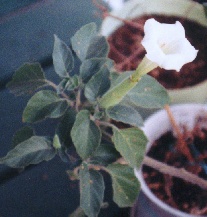 Datura
DaturaLovely large white trumpet flowers with an incredible smell of Earl Gray tea and honey. Any individual flower only lasts about a day, but it seems to produce new flowers for much of the latter part of summer.
Free plants at Curbside page
Today's pile of plants, 12-Sep-1999...
Last weeks two plants were still there: Hops and unknown tree
Plus I added a whole bunch of new stuff!
The following are plants I've put out before:
Angelica,
Butterfly Bush,
Yellow Corydalis,
Crocosmia,
Foxglove,
Golden Chain Tree,
Lamium,
Lupine,
Lychnis,
Raspberry.
The remainder are new ones that I've not put out before:
 Datura
Datura
Lovely large white trumpet flowers with an incredible smell of Earl
Gray tea and honey. Any individual flower only lasts about a day, but
it seems to produce new flowers for much of the latter part of summer.
It is not cold hardy to a Seattle winter; plant one in a an
at least one-gallon pot and keep indoors on a bright windowsill over
Winter. When the flower is replaced with a thorny seed pod, leave
until it dries and cracks open, then collect the seeds. Plant next
year in lighter well-drained soil where there will be plenty of
warmth. In the pot it will want to get leggy up to 2' around and 1'
high, but you can control it. Outdoors it may get 4' high and 3'
wide.
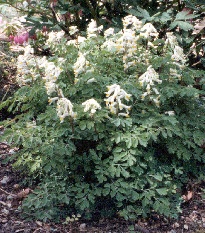 White Corydalis (C. Alba)
White Corydalis (C. Alba)
This version of Corydalis is a bit more difficult to grow than the
yellow (which is practically a
weed), though it will self sow a few plants each year. Plants are up
to 12" high, about 10" around.
When it's finished flowering, break off any old dead stems. While
doing this, if a whole chunk of plant breaks off, stick it in a pot of
good soil, and you'll have a new plant in weeks -- that's how this
very one came to be. You'll see plenty of new growth near the ground;
be sure to continue watering, and you'll get another crop of flowers.
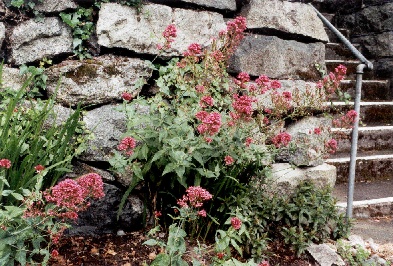 Jupiters beard
Jupiters beard
Careful, this is basically a weed, not unlike dandelions but much
nicer to look at! We've never planted it, yet as you can see in the
photo, our entire front wall is covered with it each year.
It puts out large tapering roots that can be pulled fairly easily
if in sandy soil, though it will spread. It's very forgiving
of Seattle climate, thriving on the north side of a wall where it
never gets direct sun.
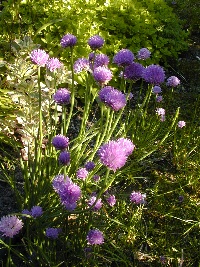 Chives
ChivesPlant this one plant in any small area that will get at least a little sun. Allow it to simply grow to seed, and be sure to spread around the seeds. You'll soon have several chive plants! Once it gets thick, be sure to just chop off the whole top, even if you're not ready to eat it all. This will sprout a whole new crop ready to go.
As seen in this photo, they make a wonderful decorative flower,
however once like this they're no longer very good eating. For best
cooking, trim when the shoots are about 6 inches tall. Once flowers
appear, simply trim the entire top of the plant off down to the
ground. (The first year let it bolt so as to get a few plants going.
This way another is coming up while you're using the first.)
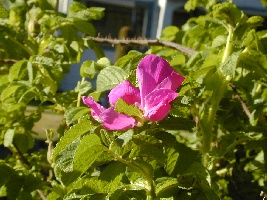 Wild Rose
Wild Rose
When picking up your plants, the mother plant is directly above you on
the rock wall at the bottom of the stairs to the left. It has nice
pink blooms in Spring. It doesn't need a lot of sun, nor a lot of
water.
It does have thorns, but they're fairly small and dense unlike show
roses. It will happily put up dozens of shoots and fill in an area.
A good choice for that space between the trees where you want to
discourage the kids from running through.